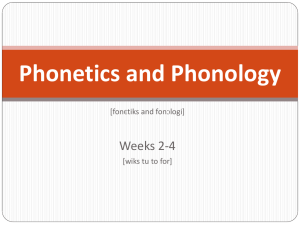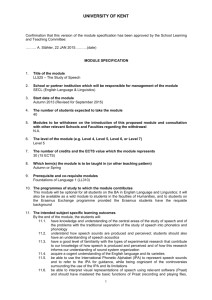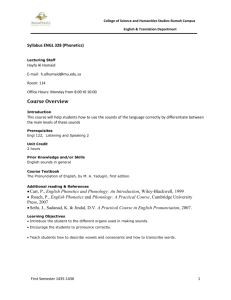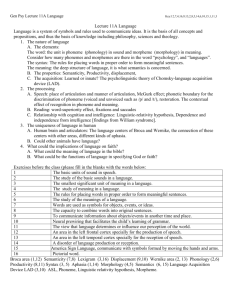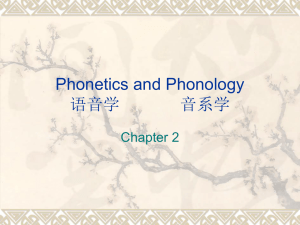Phonology Foundations of Language Science and Technology
advertisement
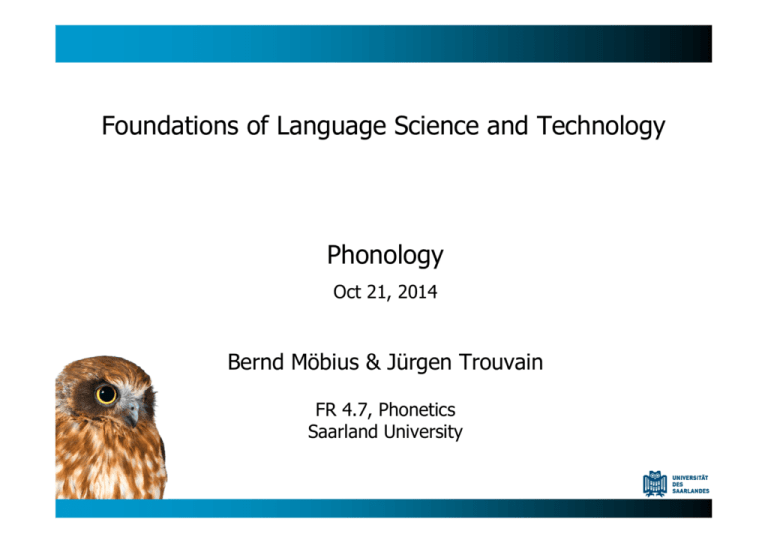
Foundations of Language Science and Technology Phonology Oct 21, 2014 Bernd Möbius & Jürgen Trouvain FR 4.7, Phonetics Saarland University Levels of linguistic description ! Phonetics ! Phonology ! Morphology ! Lexicon ! Syntax ! Semantics ! Pragmatics ! Psycholinguistics ! …linguistics (socio, neuro, patho, …) Phonology ! Scientific study of the sound system of a language ! Inventory and organization of speech sounds in a specific language Minimal pair analysis ! Determination of the phoneme inventory, by minimal pair analysis ! minimally different phonetic form ! distinct meaning ! use lists instead of pairs as shortcut hit hot hut hat fat sat cat Minimal pair analysis ! Determination of the phoneme inventory, by minimal pair analysis ! hemmen – Hennen – hängen /hɛmən/ – /hɛnən/ – /hɛŋən/ Minimal pair analysis ! Determination of the phoneme inventory, by minimal pair analysis ! hemmen – Hennen – hängen /hɛmən/ – /hɛnən/ – /hɛŋən/ Minimal pair analysis ! Determination of the phoneme inventory, by minimal pair analysis ! hemmen – Hennen – hängen /hɛmən/ – /hɛnən/ – /hɛŋən/ ! Miete – Mitte Rate – Ratte Höhle – Hölle /miːtə/ – /mɪtə/ /ʁaːtə/ – /ʁatə/ /høːlə/ – /hœlə/ Minimal pair analysis ! Determination of the phoneme inventory, by minimal pair analysis ! hemmen – Hennen – hängen /hɛmən/ – /hɛnən/ – /hɛŋən/ ! Miete – Mitte Rate – Ratte Höhle – Hölle /miːtə/ – /mɪtə/ /ʁaːtə/ – /ʁatə/ /høːlə/ – /hœlə/ Minimal pair analysis ! Determination of the phoneme inventory, by minimal pair analysis ! hemmen – Hennen – hängen /hɛmən/ – /hɛnən/ – /hɛŋən/ ! Miete – Mitte Rate – Ratte Höhle – Hölle /miːtə/ – /mɪtə/ /ʁaːtə/ – /ʁatə/ /høːlə/ – /hœlə/ → /m n ŋ iː ɪ aː a øː œ/ ! can distinguish meaning of words ! are phonemes of German Distribution analysis ! Determination of the phoneme inventory, by distribution analysis ! complementary distribution ! [ç] - [x] "nicht" [nɪçt] - "Nacht" [naxt] *[nɪxt] *[naçt] ! [h] - [ŋ] [h] only word-initial, [ŋ] never word-initial Distribution analysis ! Criterion of phonetic similarity ! [ç] ≈ [x] → /x/ (one phoneme, two allophones) ! [h] ≠ [ŋ] → /h/ /ŋ/ (two phonemes) Phonology: technical terms ! Phoneme: smallest unit that distinguishes meanings ! unit of speech in the sound system of a language that can distinguish the meanings of (pairs of) words ! distinctive / contrastive function ! phonetic differences that do not contribute to distinguishing meaning are phonologically irrelevant ! Phoneme: speech sound as structural unit, e.g. /t/ ! Phone: phonetic realization of a phoneme, e.g. [t] ! Allophone: systematic realization variant, e.g. [th] Allophones ! Allophones are free or context-dependent variants of phonemes ! free: e.g. realizations of /r/ as [rʀʁɾɣ] (in Ger., Eng.) ! context-dependent: e.g. realization of "ch" as [x] after back vowels, as [ç] elsewhere ! Problem: phonemic value of complex sounds, such as diphthongs [aɪ] [aʊ] or affricates [pf] [ts] Cf. Phonetics: technical terms ! Phone: single identified speech sound ! Features of speech sounds ! articulatory, acoustic, auditory ! Features of phonetic utterances ! segmental (pertaining to speech sounds) ! suprasegmental (exceeding individual speech sounds) ! again: articulatory, acoustic, auditory ! Dynamic processes ! coarticulation, assimilation Phoneme ! Observation: Despite systematic and statistical (chance?) variation in the realization of speech sounds, e.g. of /a/ in "Mann", we identify all these realizations as /a/. ! Evidently, some of the differences in pronunciation are contrastive and distinctive, while others are not. ! Sound differences that can distinguish the meaning of words in a language tend to become phonologized, they become elements of the phonological inventory. ! Definition: The smallest unit of speech that can distinguish the meaning of words in a language is the phoneme. Phonetics vs. Phonology Phonetics and Phonology ! Different levels of linguistic description or artificial separation of disciplines? Consider: ! describing the vowel system of a language ! "Auslautverhärtung" (neutralized voicing contrast) ! universal vs. language-specific properties of speech ! methods: experiments, measurements, statistics ! mental representations ! relation between linguistic organization and physical events ! organization of university institutes Neutralization ! Some pairs of sounds established as phonemes in a context A cannot enter a contrast in context B ! E.g. neutralization of the voicing contrast in German (and a number of other languages) ! stops and fricatives in word-final position, e.g.: ! "bunt" and "Bund" [bʊnt] ! "lies" and "ließ" [li:s] Interdisciplarity ! Phonetics and Phonology have many connections with other scientific disciplines ! communication theory, philosophy of language, logic ! sociology, psychology ! acoustics and signal processing ! clinical research and applications; language and speech disorders, speech therapy, logopedics, early diagnosis ! cognition, reading and writing, orthography ! communications technology, dialog systems: automatic speech recognition, speech synthesis, speech-to-speech translation Phonology ! Scientific study of the sound system of a language ! Inventory and organization of speech sounds in a specific language ! Classification of speech sounds by distinctive features Distinctive features ! Aims of using distinctive features ! describing of all speech sounds in all languages by means of a universal set of features ! describing phonemes/allophones of a language in terms of a vector of (mostly binary) features ! each phoneme is distinct from all others by its specific constellation of feature values ! the function of phonemes to distinguish meaning is actually achieved by distinctive features ! capturing regularities in sound systems ! forming natural classes of sounds with common properties Distinctive features ! Historical development of sets of distinctive features ! Trubetzkoy (1939), Jakobson (1939) ! Jakobson, Fant and Halle (1952) [articulatory, acoustic] ! Chomsky and Halle (1968) [SPE, Generative Phonology] ! Fant (1973) [purely acoustic] ! Ladefoged (1982) ["traditional"] ! Clements (1985) [feature geometry] ! … ! No definitive universal feature set yet ! Usually a mix of articulatory, acoustic, auditory features German consonants (Wiese, 2000) German vowels (Wiese, 2000) cf. tables for American English in Fromkin et al. p. 244f. Phonology ! Scientific study of the sound system of a language ! Inventory and organization of speech sounds in a specific language ! Classification of speech sounds by distinctive features ! Combinatorics of speech sound: phonotactics Syllable structure, Phonotactics ! Complex syllable structure of German (and English and …) "(du) strumpfst" [ʃtʁʊmpfst] /CCCVCCCCC/ ! Anything goes? ! [ʃtʁo:], aber *[ʁʃto:] ! [aʁm], aber *[amʁ] ! Language-specific: ! Georgian: [.tsvkl] [.mkr] ! German and English each have at least 12,500 distinct syllables – cf. Japanese: ~110 Syllable structure, Phonotactics ! Phonotactics: systematic description of combinatorics of speech sounds, thereby forming larger constituents ! Constraints imposed by syllable boundaries ! No universally valid definition of "syllable (boundary)" ! Syllable boundaries are difficult to determine, but counting syllables is easy (really?) ! how many syllables in "Fenster", "Papst", "schrumpfst"? ! syllable boundary in "Fenster": [fɛn.stɐ] or [fɛns.tɐ]? Syllable structure in German ! General structure: C*VC* (obligatory vowel, optionally surrounded by consonants) ! Max: CCCVCCCCC ("strumpfst" [ʃtʁʊmpfst]) ! Sonority hierarchy: syllable nucleus maximally sonorous, decreasing sonority with increasing distance from nucleus → concept much disputed ! Syllable constituents ! ONC - onset, nucleus, coda (flat) ! OR – onset, rhyme (hierarchical) ! Logatomes: phonotactically possible but non-existant syllables or words Phonology ! Scientific study of the sound system of a language ! Inventory and organization of speech sounds in a specific language ! Classification of speech sounds by distinctive features ! Combinatorics of speech sound: phonotactics ! Suprasegmental units and features Phonetics/Phonology: Prosody ! Prosody comprises properties of spoken language beyond single sounds ! intonation: accenting, phrasing, sentence mode ! ambiguities ! "Ja zur Not geht's auch am Samstag" ! "Flying planes can be dangerous." ! discourse and information structure ! Carter called Nixon a Republican, and then he offended him. Phonetics/Phonology: Prosody ! Prosody comprises properties of spoken language beyond single sounds ! intonation: accenting, phrasing, sentence mode ! ambiguities ! "Ja zur Not geht's auch am Samstag" ! "Flying planes can be dangerous." ! discourse and information structure ! Carter called Nixon a Republican, and then he offended him. ! Carter called Nixon a Republican, and then he offended him. Phonetics/Phonology: Prosody ! Prosody comprises properties of spoken language beyond single sounds ! intonation: accenting, phrasing, sentence mode ! ambiguities ! "Ja zur Not geht's auch am Samstag" ! "Flying planes can be dangerous." ! discourse and information structure ! Carter called Nixon a Republican, and then he offended him. ! Carter called Nixon a Republican, and then he offended him. ! Carter called Nixon a Republican, and then he offended him. Suggested exercises, readings, online resources ! Apply the minimal pair and distribution tests to establish the phoneme inventory of (British or American or …) English ! Exercises 10a-c, 13, 14, 24, 25 (incl. text p. 227ff.) in Fromkin et al. p. 273ff. ! Richard Wiese (2000): The Phonology of German. Oxford Univ. Press. ! Vowels and consonants in the world's languages [http://www.phonetics.ucla.edu/] Thanks!

